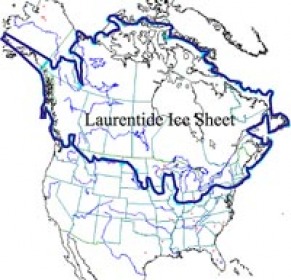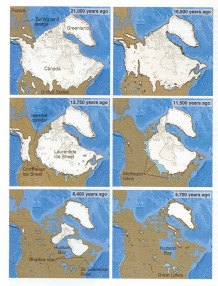Geology of Middlesex County
What Happened When The Laurentide Ice Sheet Was Retreating
Thousands of years ago, the Laurentide Ice Sheet spread across much of the northern part of North America. It was a massive ice sheet (mass of ice that covers surrounding terrain). The retreat of the ice sheet formed many of the familiar features in the northeast of America. The ice sheet stretched across North America from about 95,000 years before the present until it began to retreat around 20,000 years ago. While retreating, the ice sheet left many depositional features throughout the northeast.
After the peak of the ice age, the glacier's ablasion was greater then the accumulation and it began to retreat back to northern Canada. Because of the glaciers retreat, a lot of debris was left behind, such as till and large erratics.The retreat of the glacier also formed things such as eskers and kettle lakes. During the melt of the glacier, the ice left behind much of what it was carrying as well of large chunks of ice, that later melted to form Glacial Lake Concord and Sudbury. These lakes have since disappeared, but geologists can tell where they once were because of evidence that is still there, such as Author's Ridge (a kame delta) in Concord MA that dammed the water.
After the peak of the ice age, the glacier's ablasion was greater then the accumulation and it began to retreat back to northern Canada. Because of the glaciers retreat, a lot of debris was left behind, such as till and large erratics.The retreat of the glacier also formed things such as eskers and kettle lakes. During the melt of the glacier, the ice left behind much of what it was carrying as well of large chunks of ice, that later melted to form Glacial Lake Concord and Sudbury. These lakes have since disappeared, but geologists can tell where they once were because of evidence that is still there, such as Author's Ridge (a kame delta) in Concord MA that dammed the water.
The most common depositional feature of the Laurentide Ice Sheet is till, which covers most of the ground of the northeast. Till is a thin layer of a mixture of dirt, clay, rocks, silt, and sand and can be found all over the northeast. The ice sheet also deposited sediments into many glacial lakes while it was retreating.



